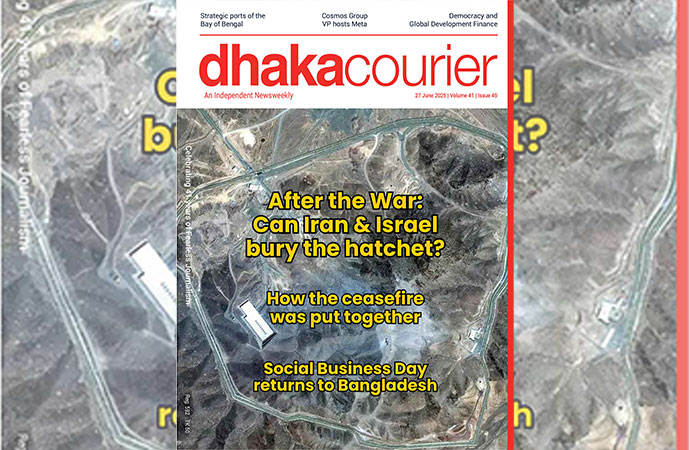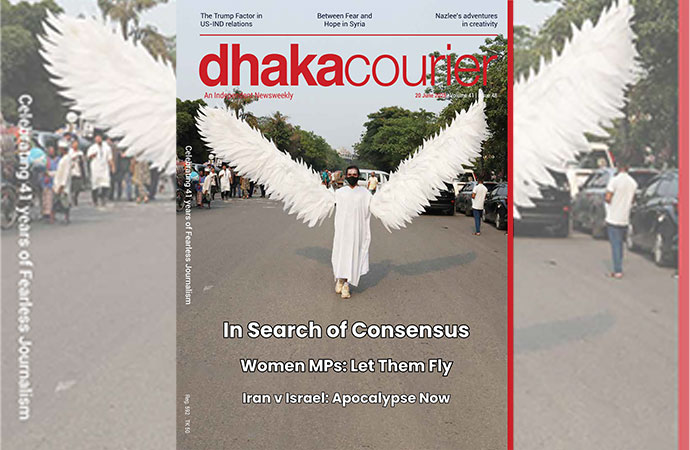Column

Indian & Bangladesh Armies conducting Counter Insurgency & Counter Terrorism ops in forest area of Bangladesh (Internet)
The relations between Bangladesh and Indian armies began in 1971 when Indian soldiers and Bangladeshi Muktijodhhas (Freedom Fighters) fought shoulder-to-shoulder and shed blood together for the independence of Bangladesh. The first helicopters and ships for Bangladesh armed forces were provided by India.
India has always been helpful and supportive in the capacity building process of Bangladesh in defence and security. Since then both the countries are working together to broadening bilateral defence cooperation.
Some believe that in the absence of the bilateral documents, it's not always possible to take further advantage of the mutual camaraderie of two friendly countries in the defence sphere and to carry forward the existing cooperation.
Accordingly, it is a logical step to have agreement in bilateral cooperation in defence between both the countries. Joint research and rescue operation in the high sea, humanitarian assistance and disaster relief, technical training, capacity building of experts, and advance the medical treatment of Bangladesh defence personnel in India are among the areas of ongoing cooperation.
The two neighbours' armed forces have been conducting joint exercises and training programme for quite a long time, and the latest exercise took place last year in Tangail (Bangladesh) focusing on counter-terrorism. High-level defence visits are normal phenomena.
The first ever visit of the Indian defence minister also took place in November 2016. The Indian Media also reported that Monohar Parikkar's visit was the first time an Indian defence minister had come to Bangladesh in 45 years. The minister and the 11 member delegation landed in Dhaka on a special Indian flight at Bangladesh air force base at Kurmitola according to statement of Inter Service Public Relation (ISPR) Directorate.
The chief of navy and air force, Border Guard Bangladesh and Coast Guard of Bangladesh visited India in December 2016.
Both sides' border forces have been co-ordinating border management while coast guards have developed a Standard Operating Procedure (SOP) for cooperation.
The Indian side is known to have assured that any progress in the defence sector will be done at the 'comfort level' of Bangladesh to avoid negative comments from the opposition parties. There is no 'element' to press for which Bangladesh may find not suitable to its need.
India, which already promised a $3 billion line of credit, is planning to extend another in the tune of $4 billion or more to fund dozens of development projects. It is noted that some $200 million from the first line of credit was later converted to a grant for "Padma Setu Project."
They also have collaboration in a field called 'port calling' under which each other's ships can drop anchor in listed ports and remain moored for a period of time. There has been a significant bilateral collaboration between the two countries in the areas of cyber security, IT, space and nuclear energy. It is noted that Bangladesh has sent "Bangabandhu Satellite-1" is the first Bangladeshi geostationary communications satellite, which was launched on May 11, 2018 from the US Space Centre.
High-level defence visits are normal phenomena between the two countries. . The chief of navy and air force, Border Guard Bangladesh and Coast Guard of Bangladesh visited India last year.
It is an undisputed fact that two armed forces collaborate with each other in many fields forces." As a result of defence cooperation, 17 officers of Bangladesh Army attended different courses in the Army War College in the last two years and another two are likely to arrive late 2018.
Another aspect of the proposed defence document is cooperation in the field of training and capacity building. India has positively considered all requests for training from Bangladesh.
Now the capacity and capability of Bangladesh's defence forces are improving and meeting that demand of technical and logistic support, Bangladesh may consider establishing training, manufacturing and maintenance centres within the country. India is known to have proposed cooperation in this regard as well.
Bangladesh and China signed a defence cooperation agreement in December 2002 during the period of the then prime minister Khaleda Zia. It is noted that Bangladesh's armed forces are predominantly equipped with Chinese military hardware. Army's tanks and fighters are of Chinese origin. Navy's frigates and patrol crafts are mostly Chinese. Air force's combat aircraft are all Chinese.
In November 2016, Bangladesh, seeking to boost its naval power in the Bay of Bengal, paid China a reported $203m for the two submarines- Nabajatra and Joyjatra. . The addition of the Chinese-supplied submarines, Bangladesh Navy can be considered a "three-dimensional force" for the first time. The Type 035G-class submarines, also known as Ming-class, were reportedly assembled at the Dalian state's Liaonan shipyard. The submarines are a class of diesel-electric submarines used by the People's Liberation Army Navy. They are 76 metres in length and 7.6 metres in width.
This deal, which reflects Bangladesh's growing economic and defence ties with Beijing, has intensified the transnational tug of war between India and China to sway Bangladesh towards either of the nations.
When Chinese President Xi visited Bangladesh in October 2016, 27 deals, amounting to some $25 billion, were reportedly signed. This caused Indian authorities to feel some concern and India sent its Defence Minister Manohar Parrikar to Bangladesh in November 2016 to ensure long-term cooperation between the nations in matters of defence. India reportedly offered Bangladesh a $500 million line of credit for the purchase of military hardware Bangladesh and Indian armed forces have been conducting joint exercises and training programme for quite a long time, and the latest exercise took place last year in Tangail (Bangladesh) focusing on counter-terrorism.
It is noted that building upon its recent surge in commercial ties with Russia, Bangladesh in 2015 signed onto purchasing seven Mi-171Hip helicopters from Moscow. The order is composed of six Mi-171Sh assault-transport helicopters and one Mi-171E transport helicopter.
The Mi-171Sh is an assault variant of the globally popular and venerable Mi-17 utility transport helicopter. With the capacity to be equipped with rocket-cannons, the Mi-171Sh can engage in limited combat with ground targets. Its cockpit has also been adapted for use with night-vision-goggles.
This deal in 2015 is the latest in a string of major acquisitions by Bangladesh from Russia. The other notable purchase from Russia was 16 Yak-130 advanced trainer and light fighter aircraft in late 2014. The Bangladesh Air Force also operates 8 MiG-29 multi-role fighters.
Finally, the forward momentum generated at both the political and military levels in Bangladesh will only lead to closer defence relations with another country provided the potential pitfalls are identified and avoided, and there is greater clarity on the end-goals of closer defence cooperation.
Barrister Harun ur Rashid, Former Bangladesh Ambassador to the UN, Geneva.

























Leave a Comment
Recent Posts
Cosmos Group VP Nahar Khan hos ...
A visiting delegation from Meta, the parent company of Facebook, Insta ...
Break the gloom, build a bette ...
Emphasising the transformative power of social business and its strong ...
‘Mobocracy’ must not prevail
The US Supreme Court allowed the Trump administratio ..
Germany dependable partner in our development journe ..
15th edition of Social Business Day: Prof Yunus to j ..